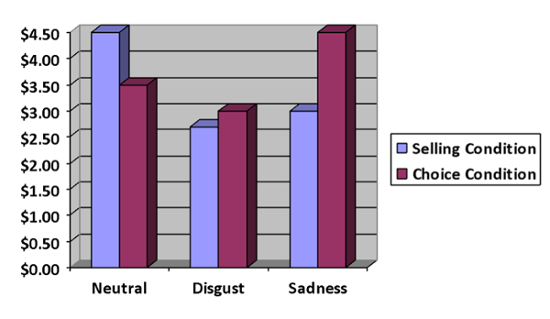Inducing Emotions
Source: William Brady & Jay Van Bavel—New York University
Psychologists have long known that people behave differently in good moods versus bad moods, and this general principle extends to consumer behavior. Economists, as well, have come to appreciate that an individual’s financial decisions are not solely the result of extensive cost-benefit calculations; other factors like emotion are at play. Further, incidental emotions affect the behavior of buyers and sellers even though they are unrelated to the transaction at hand. While earlier research focused on the impact of global feelings (positive-negative), more recent research examines more specific emotions (e.g., anger and fear). In consumer settings, research shows that anger triggers greater risk-seeking behavior among buyers and sellers and that fear triggers the opposite, i.e., conservative behavior.
The following experiment tests how two specific negative emotions—disgust and sadness—influence people’s financial valuation of objects.1 The experiment examines the relationships between induced emotional states (disgust and sadness) and the endowment effect. Inherent in this experiment is a common technique for inducing specific emotions in a laboratory setting. Once the emotions are created, they can then be implemented in a number of experimental conditions.
1. Participant Recruitment
- Conduct a power analysis and recruit a sufficient number of participants with a diversity of age and gender.
- Randomly assign participants in the experimental and control conditions.
2. Data Collection
- Seat participants in individual cubicles, each equipped with a computer and headphones.
- Tell participants that they were going to complete two separate studies and give participants two packets of material, one for each
The data (Figure 1) show support for the idea that compared to the neutral condition, sadness decreased the prices for those in the selling condition, but increased prices for those in the choice condition. However, compared to the neutral condition, disgust reduced prices for participants in both the selling and choice conditions.

Figure 1: Results showing average
Although they are both negative emotions, disgust and sadness trigger different economic behavior. Disgust triggers the psychological need to expel, thus reducing both buying and selling prices. Conversely, sadness triggers the psychological need to change one’s circumstances, thus increasing buying prices and decreasing selling prices. With disgust, the endowment effect is eliminated, whereas with sadness the effect is reversed.
Emotion and cognition influence one another. Our appraisal
- Lerner, J. S., Small, D. A., & Lowenstein, G. (2004). Heart strings and purse strings: Carryover Effects of emotions on economic decisions. Psychological Science, 15, 337-341.
スキップ先...
このコレクションのビデオ:

Now Playing
Inducing Emotions
Social Psychology
15.5K 閲覧数

Analyzing Situations in Helping Behavior
Social Psychology
41.3K 閲覧数

Using fMRI to Dissect Moral Judgment
Social Psychology
11.4K 閲覧数

Perspectives on Social Psychology
Social Psychology
8.5K 閲覧数

Evaluating the Accuracy of Snap Judgments
Social Psychology
21.0K 閲覧数

A Minority of One: Conformity to Group Norms
Social Psychology
17.1K 閲覧数

Misattribution of Arousal and Cognitive Dissonance
Social Psychology
16.6K 閲覧数

Marginal Dishonesty: The Adding-to-10 Task
Social Psychology
6.3K 閲覧数

Ostracism: Effects of Being Ignored Over the Internet
Social Psychology
10.6K 閲覧数

Persuasion: Motivational Factors Influencing Attitude Change
Social Psychology
25.6K 閲覧数

Creating the Minimal Group Paradigm
Social Psychology
25.4K 閲覧数

The Implicit Association Test
Social Psychology
52.0K 閲覧数

Nonconscious Mimicry Occurs when Affiliation Goals are Present
Social Psychology
7.9K 閲覧数

Effects of Thinking Abstractly or Concretely on Self-control
Social Psychology
6.5K 閲覧数

Thinking Too Much Impairs Decision-Making
Social Psychology
11.0K 閲覧数
Copyright © 2023 MyJoVE Corporation. All rights reserved